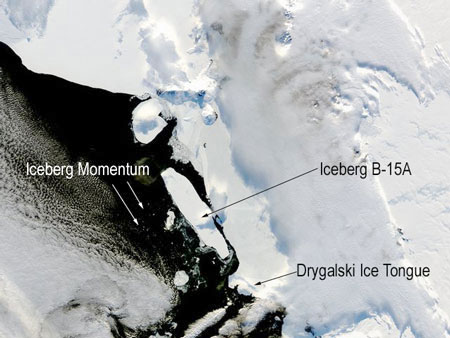A 160-mile-long floating iceberg is moving toward the Antarctic ice sheet, and may break it. NASA scientists say that the collision, a rare and extreme event, will occur by January 15
Coordinator, Avi Blizovsky

An oversized floating iceberg is on a collision course with an ice tongue near the McMurdo Research Station in Antarctica. NASA satellites detected a 160-kilometer-long glacier, known as B-15A, advancing towards the "Drygalsky" ice tongue. The pace of the glacier's progress has slowed down in recent days, but NASA scientists predict that the collision will occur no later than January 15th of this year.
"This is a collision of titans, a rare and radical event," said Robert Bindschedler, a researcher at NASA's Goddard Center. "If the two giant ice floes meet, we will see the world's most devastating collision event. "Even a slight tap of the glacier has tremendous power. This collision will definitely be stronger than the ice tongue has ever experienced."
Advertisement When the ice tongue and the glacier collide, the impact will likely "cause a dent in the 'bumper'," says Bindschedler. It is possible that the edges will "wrinkle", and ice will accumulate or drift into the sea. If the B-15A Iceberg gains enough speed before impact, the spectacle could be much more spectacular. The Drygalsky Ice Tongue can break.
An ice tongue is dense and thick ice that has accumulated in the sea in Antarctica, around a glacier with a continental base. The area of the B-15A glacier is 3,000 square kilometers, and this "monster" is known as a source of disaster. This is the largest "piece" of a much larger glacier, which broke off in March 2000.
When B15-A meets Drigalski
The block of ice is moving towards the glacier at a speed of one and a half kilometers per day. In three days they will collide (maybe), then the sky is the limit
Scientists are these days closely monitoring the movement of a huge block of ice, floating in the Southern Ice Ocean on a collision course with a glacier. The expected collision should open a sea route to the American research station McMurdo, helping many penguins reach hunting grounds.
Ice block B15-A, which is about 100 km long and made of ice capable of supplying drinking water to the entire world for several months, was once part of ice block B15, which fell off the "Ross" ice shelf off the coast of Antarctica about five years ago. B15-A has been drifting slowly towards the floating tip of the Drigalski glacier for several months, and now scientists believe that they are most likely to collide. "A collision is highly probable, given the behavior of the ice block over the past four years," says Australian Antarctic researcher Neil Young.
The US National Research Foundation (NSF) expected the collision to occur before Christmas, while the US space agency (NASA) estimated that the collision would occur by January 15. Today (Monday), Young, who belongs to the Atlantic Collaborative Research Center for Climate and Ecosystems, says that the distance between the ice block and the glacier is about five kilometers, and the block is advancing about one and a half kilometers per day - so the collision is expected to occur on Thursday. However, Yang emphasizes that it is still not certain that there will actually be a collision, as storms and ocean currents may still divert the ice block from its course.
According to Young, a collision, if it occurs, will cause a large chunk to fall from the ice block, allowing it to move away from the Ross Island area, thus making it easier for icebreakers to reach McMurdo Station, as well as a nearby New Zealand base. In addition, according to him, this situation will greatly shorten the way that the groups of penguins living in the area have to go to the open sea, where they can find food for their offspring and increase the penguin population.
On the other hand, a collision could also drop a piece of the "Drigalski" glacier, which could increase the density in the sea route leading to the Italian research station "Marie Zucchelli". Young, who tracks B15-A's movements using NASA and European Space Agency satellites, says the last time a piece fell off the glacier was in 1956. "This is without a doubt the most significant event in this region for a long time", he concludes.
